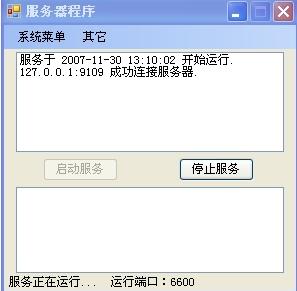最近也在接触SOCKET编程,在当今这样一个网络时代,很多技术都以网络为中心在诞生,至少我认为是这样的,而SOCKET套接字接口,在实现网络通讯上处于关键地位,所以不会SOCKET是不行的。
首先,本文主要是针对那些刚接触SOCKET编程的朋友,如果是高手,就可以不看此文啦
在开始之前,我们需要预习一些基础知识:
什么是SOCKET套接字?
SOCKET通常有那几种数据格式?
线程的概念?
(以上基本知识我就不讲了,网上这方面资料很多的,大家找资料看下吧)
我要介绍的是一个服务器端+客户端的聊天系统,程序比较简单,我先把程序运行的界面给大家看下:
上面是服务器端运行界面;下面把客户端界面贴给大家看下:

功能比较简单,服务器的端口号可以在“系统菜单”里面的参数配置进行修改的。
看了上面的图,下面我们就给大家把代码贴出来:(因为程序比较简单,所以本人就没有去分层啦)
服务器端代码:
- using System;
- using System.Collections.Generic;
- using System.ComponentModel;
- using System.Data;
- using System.Drawing;
- using System.Text;
- using System.Windows.Forms;
- using System.Net;
- using System.Net.Sockets;
- using System.Threading;
- using System.Xml;
- namespace Server
- {
- public partial class ServerMain : Form
- {
- public ServerMain()
- {
- InitializeComponent();
- }
- private void ServerMain_Load(object sender, EventArgs e)
- {
- this.CmdStar.Enabled = true;
- this.CmdStop.Enabled = false;
- }
- private void 配置参数ToolStripMenuItem_Click(object sender, EventArgs e)
- {
- Set TSet = new Set();
- TSet.ShowDialog();
- }
- private void 关于ToolStripMenuItem_Click(object sender, EventArgs e)
- {
- About TAbout = new About();
- TAbout.Show();
- }
- /// < summary>
- /// 获得XML文件中的端口号
- /// < /summary>
- /// < returns>< /returns>
- private int GetPort()
- {
- try
- {
- XmlDocument TDoc = new XmlDocument();
- TDoc.Load("Settings.xml");
- string TPort = TDoc.GetElementsByTagName("ServerPort")[0].InnerXml;
- return Convert.ToInt32(TPort);
- }
- catch { return 6600; }//默认是6600
- }
- //声明将要用到的类
- private IPEndPoint ServerInfo;//存放服务器的IP和端口信息
- private Socket ServerSocket;//服务端运行的SOCKET
- private Thread ServerThread;//服务端运行的线程
- private Socket[] ClientSocket;//为客户端建立的SOCKET连接
- private int ClientNumb;//存放客户端数量
- private byte[] MsgBuffer;//存放消息数据
- private void CmdStar_Click(object sender, EventArgs e)
- {
- ServerSocket = new Socket(AddressFamily.InterNetwork, SocketType.Stream, ProtocolType.Tcp);
- ServerInfo=new IPEndPoint(IPAddress.Any,this.GetPort());
- ServerSocket.Bind(ServerInfo);//将SOCKET接口和IP端口绑定
- ServerSocket.Listen(10);//开始监听,并且挂起数为10
- ClientSocket = new Socket[65535];//为客户端提供连接个数
- MsgBuffer = new byte[65535];//消息数据大小
- ClientNumb = 0;//数量从0开始统计
- ServerThread = new Thread(RecieveAccept);//将接受客户端连接的方法委托给线程
- ServerThread.Start();//线程开始运行
- CheckForIllegalCrossThreadCalls = false;//不捕获对错误线程的调用
- this.CmdStar.Enabled = false;
- this.CmdStop.Enabled = true;
- this.StateMsg.Text = "服务正在运行"+" 运行端口:"+this.GetPort().ToString();
- this.ClientList.Items.Add("服务于 " + DateTime.Now.ToString() + " 开始运行.");
- }
- //接受客户端连接的方法
- private void RecieveAccept()
- {
- while (true)
- {
- ClientSocket[ClientNumb] = ServerSocket.Accept();
- ClientSocket[ClientNumb].BeginReceive(MsgBuffer, 0, MsgBuffer.Length, 0, new AsyncCallback(RecieveCallBack),ClientSocket[ClientNumb]);
- this.ClientList.Items.Add(ClientSocket[ClientNumb].RemoteEndPoint.ToString()+" 成功连接服务器.");
- ClientNumb++;
- }
- }
- //回发数据给客户端
- private void RecieveCallBack(IAsyncResult AR)
- {
- try
- {
- Socket RSocket = (Socket)AR.AsyncState;
- int REnd = RSocket.EndReceive(AR);
- for (int i = 0; i < ClientNumb; i++)
- {
- if (ClientSocket[i].Connected)
- {
- ClientSocket[i].Send(MsgBuffer, 0, REnd,0);
- }
- RSocket.BeginReceive(MsgBuffer, 0, MsgBuffer.Length, 0, new AsyncCallback(RecieveCallBack), RSocket);
- }
- }
- catch { }
- }
- private void CmdStop_Click(object sender, EventArgs e)
- {
- ServerThread.Abort();//线程终止
- ServerSocket.Close();//关闭SOCKET
- this.CmdStar.Enabled = true;
- this.CmdStop.Enabled = false;
- this.StateMsg.Text = "等待运行";
- this.ClientList.Items.Add("服务于 " + DateTime.Now.ToString() + " 停止运行.");
- }
- }
- }
客户端代码:
- using System;
- using System.Collections.Generic;
- using System.ComponentModel;
- using System.Data;
- using System.Drawing;
- using System.Text;
- using System.Windows.Forms;
- using System.Net;
- using System.Net.Sockets;
- namespace Client
- {
- public partial class ClientMain : Form
- {
- public ClientMain()
- {
- InitializeComponent();
- }
- private IPEndPoint ServerInfo;
- private Socket ClientSocket;
- private Byte[] MsgBuffer;
- private Byte[] MsgSend;
- private void ClientMain_Load(object sender, EventArgs e)
- {
- this.CmdSend.Enabled = false;
- this.CmdExit.Enabled = false;
- ClientSocket = new Socket(AddressFamily.InterNetwork, SocketType.Stream, ProtocolType.Tcp);
- MsgBuffer = new Byte[65535];
- MsgSend = new Byte[65535];
- CheckForIllegalCrossThreadCalls = false;
- Random TRand=new Random();
- this.UserName.Text = "用户" + TRand.Next(10000).ToString();
- }
- private void CmdEnter_Click(object sender, EventArgs e)
- {
- ServerInfo = new IPEndPoint(IPAddress.Parse(this.ServerIP.Text), Convert.ToInt32(this.ServerPort.Text));
- try
- {
- ClientSocket.Connect(ServerInfo);
- ClientSocket.Send(Encoding.Unicode.GetBytes("用户: " + this.UserName.Text + " 进入系统!\n"));
- ClientSocket.BeginReceive(MsgBuffer, 0, MsgBuffer.Length, 0, new AsyncCallback(ReceiveCallBack), null);
- this.SysMsg.Text += "登录服务器成功!\n";
- this.CmdSend.Enabled = true;
- this.CmdEnter.Enabled = false;
- this.CmdExit.Enabled = true;
- }
- catch
- {
- MessageBox.Show("登录服务器失败,请确认服务器是否正常工作!");
- }
- }
- private void ReceiveCallBack(IAsyncResult AR)
- {
- try
- {
- int REnd = ClientSocket.EndReceive(AR);
- this.RecieveMsg.AppendText(Encoding.Unicode.GetString(MsgBuffer, 0, REnd));
- ClientSocket.BeginReceive(MsgBuffer, 0, MsgBuffer.Length, 0, new AsyncCallback(ReceiveCallBack), null);
- }
- catch
- {
- MessageBox.Show("已经与服务器断开连接!");
- this.Close();
- }
- }
- private void CmdSend_Click(object sender, EventArgs e)
- {
- MsgSend = Encoding.Unicode.GetBytes(this.UserName.Text + "说:\n" + this.SendMsg.Text + "\n");
- if (ClientSocket.Connected)
- {
- ClientSocket.Send(MsgSend);
- this.SendMsg.Text = "";
- }
- else
- {
- MessageBox.Show("当前与服务器断开连接,无法发送信息!");
- }
- }
- private void CmdExit_Click(object sender, EventArgs e)
- {
- if (ClientSocket.Connected)
- {
- ClientSocket.Send(Encoding.Unicode.GetBytes(this.UserName.Text + "离开了房间!\n"));
- ClientSocket.Shutdown(SocketShutdown.Both);
- ClientSocket.Disconnect(false);
- }
- ClientSocket.Close();
- this.CmdSend.Enabled = false;
- this.CmdEnter.Enabled = true;
- this.CmdExit.Enabled = false;
- }
- private void RecieveMsg_TextChanged(object sender, EventArgs e)
- {
- this.RecieveMsg.ScrollToCaret();
- }
- private void SendMsg_KeyDown(object sender, KeyEventArgs e)
- {
- if (e.Control && e.KeyValue == 13)
- {
- e.Handled = true;
- this.CmdSend_Click(this, null);
- }
- }
- }
我只对服务器端的代码做了注释,客户端就没有写注释了,因为代码是差不多的。区别在于客户端不需要监听,也不需要启用线程进行委托。
关于 ServerSocket = new Socket(AddressFamily.InterNetwork, SocketType.Stream, ProtocolType.Tcp);
这句代码,我想给初学者解释一下,这里“AddressFamily.InterNetwork”表示的是使用IPV4地址,“SocketType.Stream”表示使用的是流格式(另外还有数据包格式和原始套接字格式),“ProtocolType.Tcp”表示使用TCP协议(另外还有很多其它协议,例如大家常看到的UDP协议)。
服务器端+客户端的聊天系统就介绍完了。另外关于SOCKET类中的BeginReceive方法,请大家参考MSDN,里面有详细说明。
【编辑推荐】



























